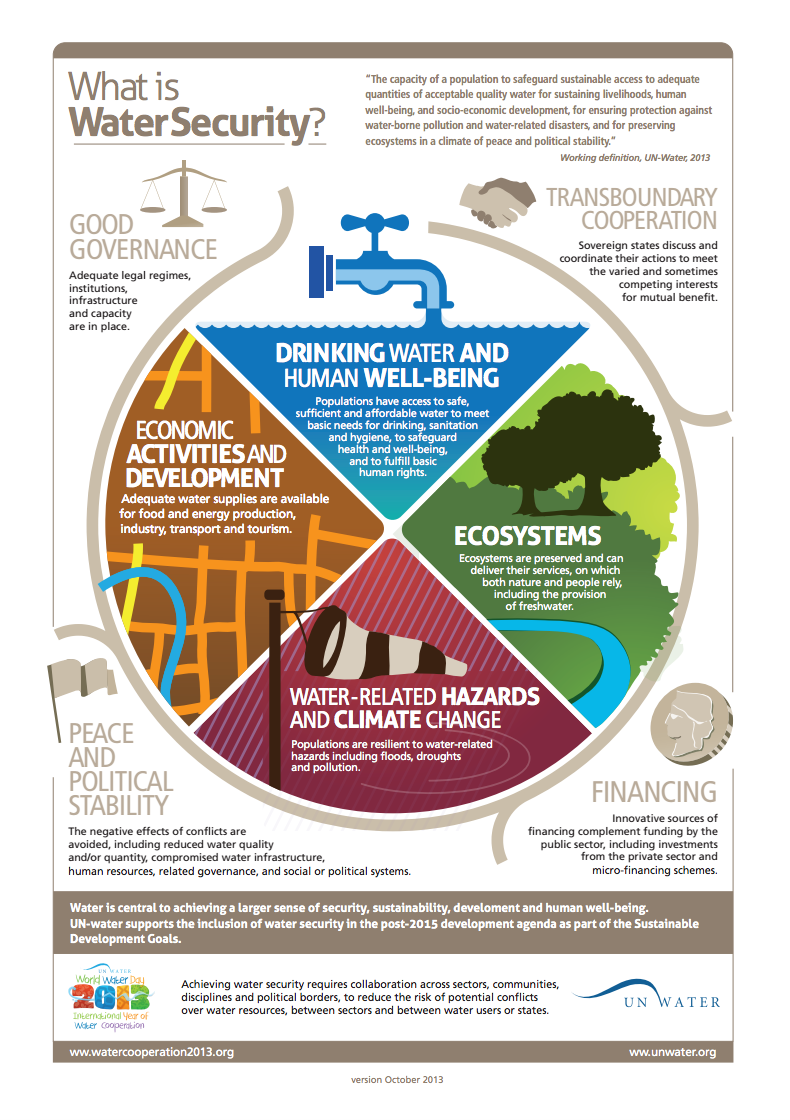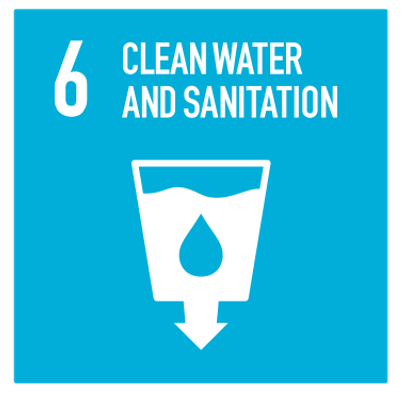2.1 Water Security Definitions
2.1 What does “Water Security” mean?
’’The capacity of a population to safeguard sustainable access to adequate quantities of and acceptable quality water for sustaining livelihoods, human well-being, and socio-economic development, for ensuring protection against water-borne pollution and water-related disasters, and for preserving ecosystems in a climate of peace and political stability’’ (UN Water, 2013).

What is Water Security? Infographic (UN, 2013).
UN Water (2013) suggested a „Water Security“ concept addressing key aspects of water related challenges. Their infographic shows key aspects of water security:
- Access to safe and sufficient drinking water at an affordable cost
- Protection of livelihoods, human rights, and cultural and recreational values
- Preservation and protection of ecosystems in water allocation and management systems
- Water supplies for socio-economic development and activities
- Collection and treatment of used water to protect human life and the environment from pollution
- Collaborative approaches to transboundary water resources management within and between countries
- The ability to cope with uncertainties and risks of water-related hazards
- Good governance and accountability, and the due consideration of the interests of all stakeholders
2.1.2 Key messages of SDG 6 (abridged)
Goal 6: Ensure availability and sustainable management of water and sanitation for all

SDG 6 (UN, 2020).
Target 6.1
“… safe and affordable drinking water for all”
Target 6.2
“… achieve access to adequate and equitable sanitation …”
Target 6.3
“… improve water quality …”
Target 6.4
“… increase water-use efficiency across all sectors and ensure sustainable withdrawals and supply of freshwater to address water scarcity…”
Target 6.5
“… implement integrated water resources management…”
Target 6.6
“… protect and restore water-related ecosystems…”
SDG 6 lists the key targets related to water security. This overview highlights key messages of SDG 6 in an abridged form. SDG 6 addresses crucial aspects of water security, including water security for people, ambient water quality, water use efficiency, the protection of water related ecosystems and integrated water resources management (IWRM). Aside from SDG 6, SDG 11 also addresses some water-related issues, with targets that relate to the protection against natural hazards, including hydro-meteorological hazards such as floods, droughts, and storms.
2.1.3 Earlier Definitions of Water Security
Various definitions of Water Security exist, each reflecting the perspective and purpose of their application. Most incorporate the basic elements of water resources, environment, economy, water-related disasters, and human needs. Cook and Bakker (2012) identified four complementing themes in water security frameworks: availability; water-related hazards and vulnerability to those hazards; human needs; and, environmental sustainability.
The Asian Development Bank (2013) added urban and economy, while Grey and Sadoff (2007) incorporated climate change and disease transmission into their definition of water security. This has led to a risk-based approach to water security as articulated by both Grey et al. (2013) and OECD (2013). Siwar and Ahmed (2014) used social elements of safety, access, and affordability in their framework. Given that water is essentially a coupled system (Bogardi et al. 2011) the integration of social and physical indicators is critical for representing and understanding local water security.
2.1.4 Varying Water Security assessment frameworks (view table)
Most WS frameworks incorporate basic elements of water resources, environment, economy, water-related disasters and human needs (Dickson et al., 2016). Vörösmarty et al. (2010) assessed global water security looking at human and biodiversity related factors. The ADB (2013) considered five different securities related to water: economic, household, urban, environmental, resilience.
Fischer et al. (2015) applied a hydro-economic approach; Sadoff et al. (2015) used national sub-indicators to represent the dimensions of their concept generating global maps. Gain et al. (2016) used gridded data to aggregate a final global water security index for each individual country, allowing an inter-country comparison and also to identify temporal changes for each country.
Jensen and Wu (2018) used pressure and impact related indicators to assess water security risk. Babel et al. (2020) developed a concept to assess urban water security using the example of Bangkok.
References
2.1 What does “Water Security” mean?
UN Water (2013), ‘Water Security & the Global Water Agenda: A UN-Water Analytical Brief‘, Available from: http://www.unwater.org/publications/water-security-global-water-agenda/
2.1.2 Key messages of SDG 6 (abridged)
UN, 2020, ‘Sustainable Development Goals’, https://sustainabledevelopment.un.org/sdgs
2.1.3 Earlier Definitions of Water Security
Bogardi JJ, Dudgeon D, Lawford R, Flinkerbusch E, Meyn A, Pahl-Wostl C, Vielhauer K, Vörösmarty C (2011) Water security for a planet under pressure: interconnected challenges of a changing world call for sustainable solutions. Curr Opin Environ Sustain 4(1):35–43. https://doi.org/10.1016/j.cosust.2011.12.002
Cook, C., & Bakker, K. (2012). Water security: Debating an emerging paradigm. Global Environmental Change, 22(1), 94–102. https://doi.org/10.1016/j.gloenvcha.2011.10.011
Grey, D., & Sadoff, C. W. (2007). Sink or Swim? Water security for growth and development. Water Policy, 9(6), 545–571. https://doi.org/10.2166/wp.2007.021
Sadoff, C. W., Hall, J. W., Grey, D., & Wiberg, D. (2015). Securing water, sustaining growth. Retrieved from http://www.water.ox.ac.uk/?publication=securing-water-sustaining-growth-report-of-the-gwpoecd-task-force-on-water-security-and-sustainable-growth
Siwar C, Ahmed F (2014) Concepts, dimensions and elements of water security. Pakistan J Nutrition 13(5):281–286 https://doi.org/10.3923/pjn.2014.281.286
OECD, 2013. Water Security for Better Lives, OECD Studies on Water, OECD Publishing. http://dx.doi.org/10.1787/9789264202405-en
2.1.4 Varying Water Security assessment frameworks
Vörösmarty, C. J., McIntyre, P. B., Gessner, M. O., Dudgeon, D., Prusevich, A., Green, P., … Davies, P. M. (2010). Global threats to human water security and river biodiversity. Nature, 467(7315), 555–561. https://doi.org/10.1038/nature09440